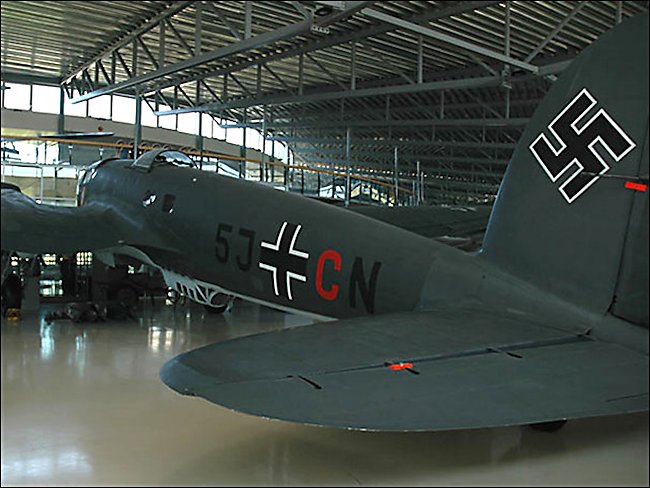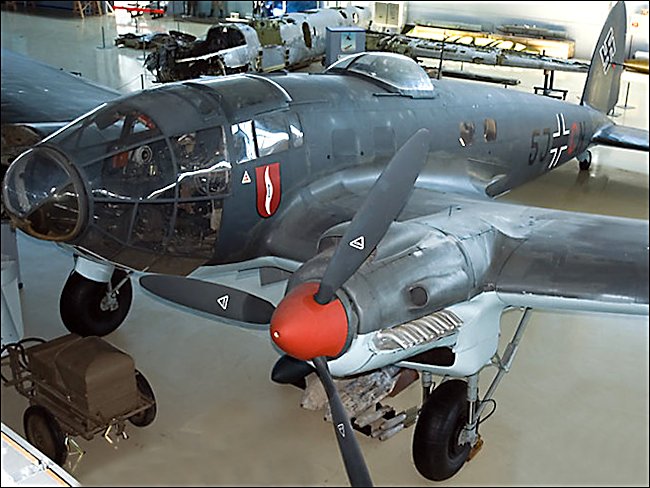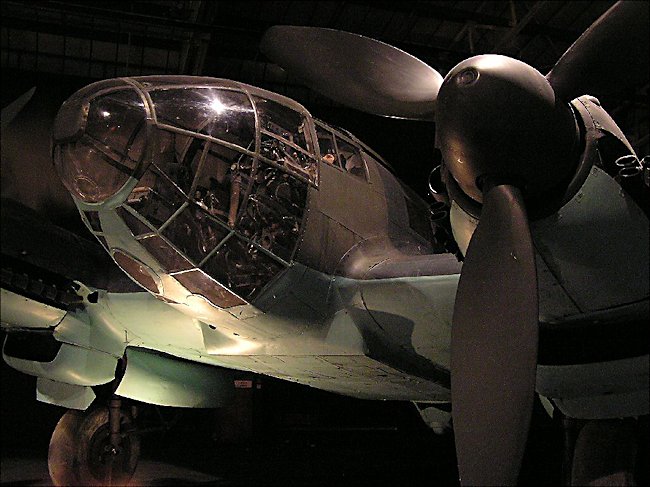Heinkel He 111 Medium Bomber
The German Luftwaffe tactics changed during the 1940 Battle of Britain and they used Heinkel He111 Medium Bombers to attack London during the blitz rather than concentrating on RAF airfields like Biggin Hill, and radar installations. This was Hitler's big mistake. If they had smashed the RAF and gained air supremacy they could have invaded England. Luckily they did not. This photograph is one of three remaining surviving Heinkels. It is a He 111H-20, Wk Nr 701152 on display at the RAF Museum Hendon, in north London. There is another Heinkel in the Norwegian Air Force Museum at Gardermoen and one at the Museo del Aire, Madrid, Spain.
The Heinkel He111-H Medium Bomber was used as the spearhead for the Blitzkrieg (lightning war) tactics so successfully used by the Nazis during the early occupation of Poland, Holland, France and Belgium. In 1936 the Heinkel He111 was sent to Spain to provide support to the right wing Spanish Nationalist Forces. It was an ideal opportunity to test their equipment and train their pilots.

The Heinkel He-111 proved to be vulnerable to British Hurricane and Spitfire fighter attacks during the Battle of Britain. So the Luftwaffe switched all Heinkel He111 attacks to night bombing raids.
By 1940 the Heinkel He111 medium Bomber was on old design that did not show its age. It was still competent at delivering a deadly blow against an enemy. It certainly rearranged the building landscape of London in the Blitz and killed thousands of people. The German aircraft designer Dr. Ernst Heinkel and owner of the Heinkel Flugzeugwerke company gave the development of a new fast passenger plane to Siegfried and Walter Gunter who recently joined his company. The He 111 first flew on 24 February 1935.

The He 111H variant was the most widely produced Heinkel during WW2. It was fitted with the 820 kW (1,100 hp) Junkers Jumo 211 engine. It was used during the invasion of Poland but found to be under armed. The total amount of machine guns on the aircraft were increased to seven. The two fuselage waist positions received an additional machine gun MG15, MG17 or MG20. The Germans managed to produce about 100 new Heinkel He111 bombers a month. Production stopped in September 1944.
The Heinkel 111 had a crew of four; pilot, navigator/bombardier/nose gunner, ventral gunner, dorsal gunner/radio operator. It had a maximum air speed of 273 mph (4490 km/h) with a range of 1,429 miles (2,300 km). It's service ceiling was 21,330 feet (6,500 meters). It could carry 2,000 kg (4,409 lb) carried internally (eight 250 kg max), or up to 2,500 kg (5,512 lb) on two external racks.

Dr. Ernst Heinkel was a member of the German Nazi party. Most people doing business with the new regime had to be a member. He was awarded the German National Prize for Art and Science in 1938, one of the rarest honors of the Hitler's German government. Dr. Ernst Heinkel had been a critic of the Nazis about being forced to sack Jewish designers and staff in 1933. The company had to use forced Jewish labor starting in 1941. Records show his company was considered a "model for slave labor." In 1942 the Nazi Government "nationalised" the Heinkel works. Dr Heinkel was detained until he sold his controlling interest in his factories to Hermann Goring.
He moved to Vienna and started a new design bureau there, working on the Heinkel He 274 design until the war ended. At the end of the war Heinkel was arrested by the Allies but evidence of anti-Hitler activities and his treatment by the regime led to his acquittal. He died in 30th January 1958. In 1959, Heinkel's company was sued by Edmund Bartl for being enriched by slave labor during World War 2, however, the German Supreme Court dismissed his claims for filing too late and ordered Bartl to pay court costs and attorney's fees

Photograph taken at the RAF Museum, Hendon, London NW9 5LL England
Unlike the Allies who introduced new larger bombers that could carry heavier and heavier bomb loads the Heinkel He111 Medium Bomber was not replaced and continued to be used until the end of World War Two. It was used as a transport aircraft on the Western, Eastern, Mediterranean, Middle Eastern, and North African Fronts. The Heinkel was used as a torpedo bomber during the Battle of the Atlantic. After the war it continued in use in the Spanish Airforce which was lucky for the makers of the Battle of Britain film as they could use them in the flying sequences.
Heinkel He 111 books


Tweet